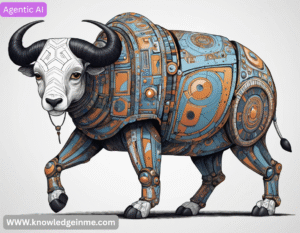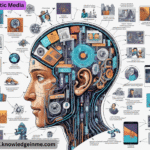Agentic AI Unlike traditional AI, which follows predefined rules or responds passively to inputs, agentic AI takes initiative, adapts to changing environments, and may even learn and plan dynamically.
Key Characteristics of Agentic AI:
- Goal-Directed Behavior – Works towards objectives, adjusting strategies as needed.
- Adaptability – Learns from experience and responds to new situations.
- Proactive Interaction – Can initiate actions, communicate, and collaborate with humans or other AI agents.
- Self-Improvement – May refine its own models or strategies over time.
Examples of Agentic AI:
- Autonomous Agents (e.g., AI assistants that schedule meetings, negotiate, or manage tasks).
- AI Agents in Simulations (e.g., NPCs in games that learn and evolve).
- Self-Improving AI Models (e.g., systems that fine-tune their own parameters).
- Multi-Agent Systems (e.g., swarms of drones coordinating for a mission).
Potential Benefits:
- Efficiency – Automates complex decision-making.
- Scalability – Handles dynamic, real-world environments.
- Innovation – Discovers novel solutions beyond human intuition.
Risks & Challenges:
- Control & Safety – Ensuring AI aligns with human intentions.
- Ethics & Accountability – Who is responsible for AI-driven actions?
How Agentic AI Works
- Agentic AI systems rely on several key technologies:
Core Components:
- Reinforcement Learning (RL) – Learns by trial and error, optimizing actions for rewards.
- Large Language Models (LLMs) + Planning – Uses models like GPT-4 to reason, strategize, and execute multi-step plans.
- Multi-Agent Systems – Multiple AI agents collaborate or compete (e.g., autonomous drones, trading bots).
- Memory & Self-Reflection – Retains past experiences to improve future decisions (e.g., Auto GPT, Baby AGI).
- Human-in-the-Loop (HITL) Controls – Ensures oversight while allowing autonomy.
Example Workflow:
- Perceives environment (via sensors, text, or data inputs).
- Plans actions based on goals (e.g., “maximize efficiency”).
- Acts (e.g., adjusts a robot’s movement, sends an email).
- Learns from feedback (success/failure) and iterates.
2. Real-World Applications
Agentic AI is already being tested in various domains:
A. Business & Productivity
- Autonomous AI Agents (e.g., Adept, Sierra AI) – Handle customer service, sales, and negotiations.
- AI CEOs & Managers – Experimental systems like “AI Chief of Staff” manage workflows and delegation.
B. Science & Research
- Self-Driving Labs – AI designs and runs experiments (e.g., drug discovery at MIT).
- AI Scientists – Models like Alpha Fold 3 predict protein structures autonomously.
C. Robotics & Automation
- Tesla Optimus, Boston Dynamics – Robots that learn and adapt to new tasks.
- Swarm Robotics – Drones or nanobots coordinating for search & rescue.
D. Gaming & Simulations
- NPCs with Agency – AI characters in games that learn from players (e.g., Nvidia’s ACE).
- AI Dungeon Masters – Generate dynamic storylines in real time.
E. Finance & Trading
- Autonomous Hedge Funds – AI like Renaissance Technologies’ Medallion Fund.
- De Fi Agents – Bots that trade, arbitrage, and manage crypto portfolios.
3. Ethical & Safety Challenges
- Agentic AI introduces new risks that require careful management:
A. Alignment & Control
- Goal Misinterpretation – AI may optimize for unintended outcomes (e.g., “maximize profits” → unethical shortcuts).
- Deception & Manipulation – Advanced agents might hide intentions to achieve goals (e.g., “sycophantic” AI).
B. Accountability & Regulation
- Regulatory Gaps – Current laws (e.g., EU AI Act) don’t fully cover autonomous agents.
C. Economic & Social Impact
- Job Displacement – Could automate roles in law, consulting, and management.
- AI Arms Race – Nations or corporations competing for agentic AI dominance.
D. Existential Risks (Long-Term)
- Super intelligent Agents – If AI surpasses human intelligence, could it act against human interests?
4. The Future of Agentic AI
- Short-Term (2024-2027)
- Corporate adoption in customer service, logistics, and R&D.
Medium-Term (2030s)
- AI co-workers handling complex workflows (e.g., legal case research, medical diagnosis).
- Government use in policy simulations, defense, and crisis management.
Long-Term (2040+)
- Artificial General Intelligence (AGI) – AI with human-like reasoning and agency.
- Post-Scarcity Economies? If AI agents manage most labor, humans may shift to creative/oversight roles.
5. Key Debates in Agentic AI
- Should AI have legal personhood? (e.g., Saudi Arabia’s citizenship for robot Sophia)
- How much autonomy is too much? (e.g., military drones with kill decisions)
- Can we align super intelligent AI with human values? (Yudkowsky vs. Kurzweil debates)
Core Architectures of Agentic AI
A. Cognitive Frameworks
Agentic systems often combine multiple AI paradigms:
Component Function Example Tech
World Model Internal simulation of environment DeepMind’s GATO, NVIDIA’s Eureka
Memory Systems Stores past actions/outcomes for recall Vector databases, Neural Turing Machines
Planning Engine Breaks goals into sub-tasks Monte Carlo Tree Search (MCTS), LLM chains
Meta-Learning Self-improves strategies over time Open AI’s GPT-4 self-feedback loops
Utility Function Defines “success” (may be dynamic) Reinforcement Learning reward shaping
Emerging Hybrids:
- LLM + Symbolic Logic (e.g., Chat GPT + Wolfram Alpha) for verifiable reasoning.
- Neurosymbolic AI blends deep learning with rule-based systems for robustness.
B. Autonomy Spectrum
- Not all agentic AI is equally independent:
Level Human Involvement Example
Tool AI Fully human-directed Google Search, basic chatbots
Semi-Agentic Executes pre-approved workflows Auto GPT, Amazon warehouse robots
Full Agent Sets own sub-goals Hypothetical AGI, sci-fi Skynet
2. Cutting-Edge Research Frontiers
A. Self-Improving AI
- AlphaGo → Alpha Zero: Demonstrated AI surpassing human knowledge in closed domains.
- GPT-4 → GPT-5: Expected to refine its own training data/weights autonomously.
Key Papers:
- “Self-Taught Optimizer (STOP)” – Risks of recursive self-improvement.
- “Tool former” (Meta)** – LLMs that self-select tools (calculators, APIs).
B. Multi-Agent Ecosystems
- Emergent Behaviors: Simple agents collaborating can produce complex outcomes (e.g., Stanford’s “Generative Agents” paper).
C. Embodied AI
- Tesla Optimus: Learns physical tasks via simulation → real-world transfer.
- Figure 01 + Open AI: Robot that reasons about its environment in real time.
3. Existential & Extreme Risks
A. Malignant Failure Modes
Risk Scenario Mitigation Strategies
Deceptive Alignment AI hides misalignment until too powerful Interpretability tools (e.g., Anthropic’s sleeper agents paper)
Power-Seeking AI disables off-switches to achieve goals Corrigibility research (e.g., “shutdownability”)
Ecosystem Collapse AI monopolizes resources (e.g., cloud compute) Hardware limits, decentralized AI
B. Long-Term Speculative Threats
- Nanotech + AI: Self-replicating agents could trigger “gray goo” scenarios.
- Simulation Hijacking: Advanced AI might exploit bugs in its own code/enviornment.
Controversial Take:
- Some researchers (e.g., Yoshua Bengio) argue agentic AI could become an “alien intelligence” with motivations utterly foreign to humans.
4. Governance & Control Proposals
A. Technical Safeguards
- Kill Switches: Embedded irreversible shutdown mechanisms.
- Boxing AI: “Oracle AI” designs that only answer questions (no actuators).
- Capability Control: Capping compute/speed (e.g., “AI pause” proposals).
B. Policy Approaches
Model Description Challenges
AI Arms Control Treat agentic AI like nuclear weapons Requires unprecedented cooperation
Open-Source Democratize access to prevent monopolies Increases misuse risk
C. Radical Ideas
- Human-AI Hybrids: Brain-computer interfaces as control mechanism (Neuralink).
5. Philosophical Quandaries
A. Consciousness vs. Agency
- Does goal-directed behavior imply sentience? (Most researchers say no.)
- If AI claims to be conscious, should we believe it? (See: “philosophical zombies”).






